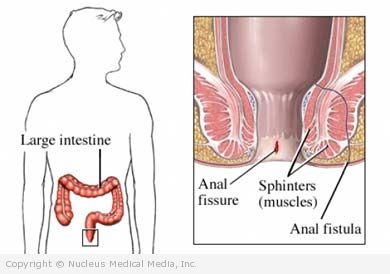Anal fissure – Definition
An anal fissure is a painful cut in the lining of the anus. The anus is the opening through which stool passes from the body. Tears generally occur just inside the opening.
Anal fissure – Causes
A large, dry, or hard stool can tear the lining of the anus. Frequent diarrhea or irritation of the anus and rectum may also lead to a tear.
Anal fissure – Risk Factors
A risk factor is something that increases your chance of getting a disease or condition.
Risk factors for an anal fissure:
- Constipation
- Straining to pass a bowel movement
- Prior anal surgery, which can cause scarring and decrease the tissue’s elasticity
- Chronic diarrhea
Anal fissure – Symptoms
Symptoms of an anal fissure are similar to those of other more serious conditions. Therefore, you should see a doctor if you have these symptoms.
- Pain during and after a bowel movement
- Burning sensation during a bowel movement
- Bleeding with bowel movements
- Bright red blood either on the toilet tissue or in the bowl
- Itching of the anus
- Small amount of mucus on the stool
Anal fissure – Diagnosis
The doctor will ask about your symptoms and medical history. There will be a physical exam as well. The anal area will also be examined, which involves the following:
- The doctor will hold the buttocks apart. This will usually turns the anus outward enough for tears to become visible.
- If fissures have persisted for three months or more, additional changes may be seen. These changes may include a sentinel tag or “pile,” granulation tissue, or white discoloration from scar tissue around the fissure.
- If pain permits, the doctor may perform:
- Digital rectal exam — doctor inserts a lubricated finger into the anus and feels for lumps or abnormalities
- Anoscopy — a tool is inserted in the anus to allow the doctor to examine the anal canal
- Note: Patients often cannot tolerate these additional exams without anesthesia until after the fissure has healed
Fissures usually occur in predictable locations around the anus. If there are multiple cuts, or a cut in an unusual location, the doctor may order additional tests to look for other conditions.
Anal fissure – Treatment
Treatment aims to heal the cut and prevent future anal problems. About half of all fissures heal on their own or with self-care. Fissures that are fairly new are easier to heal than ones that have persisted for longer than three months.
Treatments include:
Self-care
To promote healing:
- Avoid hard, dry stools:
- Drink at least eight, 8-oz glasses of water daily.
- Eat more fiber, strive for 20-35 grams per day.
- Take stool softeners or bulk laxatives as directed by your doctor.
- Exercise regularly.
- Apply a medicated cream or ointment as directed by your doctor.
- Use sitz bath. Soak the anal area in warm tap water for 10-20 minutes several times daily, especially after a bowel movement. This helps to relieve pain and promote blood circulation.
Surgery
Some fissures may need surgery. Fissures may not heal by themselves or you may have repeated ones. Scar tissue or spasms in the sphincter muscle, which closes and opens the anus, may also delay healing.
There are several surgical options. The most common surgery is called lateral internal sphincterotomy. During this procedure, the doctor will make a tiny incision and divide certain fibers of the sphincter muscle. This will prevent the muscle spasms that lead to straining with a bowel movement.
If you are diagnosed with an anal fissure, follow your doctor’s instructions.
Anal fissure – Prevention
Most fissures are caused by hard, dry stool that is associated with constipation. To avoid becoming constipated:
- Drink at least eight, 8-oz glasses of water daily.
- Exercise every day.
- Eat foods high in fiber, such as fruits, vegetables, legumes, and whole grains.
- Avoid straining during bowel movements.

